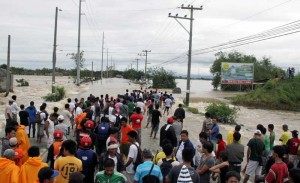Typhoon Santi (international codename Nari) cut across Northern Luzon on Saturday, killing at least 13 people and cutting off electricity to more than two million people before heading out to the West Philippine Sea (South China Sea).
The typhoon is expected to be out of the Philippine Area of Responsibility Sunday, but weather forecasters said a tropical depression in the Pacific Ocean has developed into a storm and may enter the country tomorrow. It will be named Tino once it is inside the PAR.
The Philippine Atmospheric, Geophysical, and Astronomical Services Administration (Pagasa) said it is not likely that the two storms will merge.
Santi, the strongest storm to hit Central Luzon in 25 years, damaged crops and infrastructure in the hardest-hit provinces of Nueva Ecija, Aurora, Zambales and Bulacan.
The typhoon, packing winds of 150 kilometers per hour, slammed into Aurora before midnight Saturday, ripping roofs off buildings, toppling trees and pylons as it cut a westward swathe through the farming regions of the main island of Luzon, officials said.
“While there were relatively few casualties, a lot of areas are still flooded,” Eduardo del Rosario, head of the National Disaster Risk Reduction and Management Council (NDRRMC) told a news conference.
Witnesses in the coastal town of Baler, near where Nari made landfall, said many large trees had been felled and clean-up crews with chainsaws were clearing the roads.
Government clerk Glenn Diwa, 34, said she and her husband spent a sleepless night as the typhoon roared through the town of Capas, Tarlac.
“It started close to midnight and lasted three hours. The wind was very strong and there was a whistling sound. After a while we heard torn roofing sheets clattering across the yard,” she told AFP.
As Santi moved inland, dumping rain, a wall of mud fell on a police barracks near the town of Magalang in Pampanga, killing an officer awaiting deployment to rescue typhoon victims, the civil defense office in the region said.
Elsewhere in Central Luzon, an old woman and four minors were crushed to death when trees crashed onto two houses and a vehicle, while the wall of a school collapsed and crushed an old man to death.
Another man was electrocuted by a loose power line while yet another died of a heart attack.
Two children and an elderly person drowned in Bulacan, which suffered widespread flooding, according to Governor Wilhelmino Alvarado.
Soldiers, police, and local government workers used military trucks to rescue residents in flooded communities across the towns of San Miguel and Minalin, also in Pampanga.
“The wind picked up very quickly, very dramatically. We had the wind coming right off the ocean for four hours,” said one witness on the east coast.
The typhoon caused power interruptions in the provinces of Cagayan, Quirino, Aurora, Nueva Vizcaya and Isabela.
Nueva Ecija Gov. Aurelio Umali said motorists cannot go enter or leave the province because of toppled trees and electric posts.
Umali appealed for more heavy equipment to hasten road clearing operations.
”We are intensifying our clearing operations so that motorists can pass through. Hundreds of motorists and passengers were stranded since last night,” he said.
In the towns of San Miguel and San Ildefonso in Bulacan, residents clamber up their rooftops as floodwaters rose.
Alvarado said that although the floods have subsided, some towns were still in waist-deep floodwaters.
A farmer and a woman on separate motorbikes were nearly swept away and had to be pulled back to safety by policemen when they tried to cross a street that had turned into a raging river.
Farmer Frankie Garcia, 30 said he had been forced to butcher one of his pigs after it fell ill from exposure to the rain and wanted to cross the streaming floodwaters to take some of the pork to his relatives.
“I needed to reach the other side soon, otherwise the meat would spoil,” he said.
The typhoon blacked out 37 towns and cities across the region.
Road and utility crews were out clearing roads and restoring power, but it could take up to two days before electricity is restored and major highways are reopened to traffic, Nigel Lontoc, a disaster official for the region, said.
A total of 2.1 million people live in the areas now without electricity.
Four people were listed as missing, including a fisherman on the country’s east coast who had been sleeping in his boat that was swept out to sea.
Three fishermen—Andres Timuat, 42, Edilberto Arcilla, 55 and Jose Burac, 58—were reported missing.
About 3,000 people moved into government-run shelters amid warnings their communities could be hit by flooding and landslides, Lontoc said.
The typhoon spared Metro Manila, which had been warned on Friday about possible widespread flooding.
With Reports From Afp, Pna, Celso Cajucom


